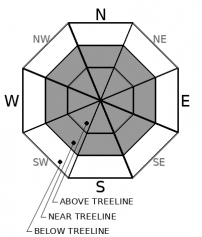| Thursday | Thursday Night | Friday | |
|---|---|---|---|
| Weather: | Sunny then becoming partly cloudy. Snow levels below 7000 feet. Chance of precipitation is 0%. | Partly cloudy then becoming mostly cloudy. Snow levels below 7000 feet. Chance of precipitation is 0%. | Partly cloudy then becoming sunny. Snow levels below 7000 feet. Chance of precipitation is 0%. |
| Temperatures: | 35 to 41 deg. F. | 13 to 18 deg. F. | 37 to 42 deg. F. |
| Mid Slope Winds: | East winds 10 to 20 mph. Gusts up to 30 mph in the morning. | Light winds. | Light winds. |
| Expected snowfall: | No accumulation. | SWE = none. | No accumulation. | SWE = none. | No accumulation. | SWE = none. |
| Thursday | Thursday Night | Friday | |
|---|---|---|---|
| Weather: | Sunny then becoming partly cloudy. Snow levels below 7000 feet. Chance of precipitation is 0%. | Partly cloudy then becoming mostly cloudy. Snow levels below 7000 feet. Chance of precipitation is 0%. | Partly cloudy then becoming sunny. Snow levels below 7000 feet. Chance of precipitation is 0%. |
| Temperatures: | 30 to 36 deg. F. | 12 to 17 deg. F. | 33 to 38 deg. F. |
| Ridge Top Winds: | Northeast to East 15 to 25 mph. Gusts up to 50 mph decreasing to 25 mph in the afternoon. | East around 15 mph. | East around 15 mph. Gusts up to 25 mph in the afternoon. |
| Expected snowfall: | No accumulation. | SWE = none. | No accumulation. | SWE = none. | No accumulation. | SWE = none. |


























